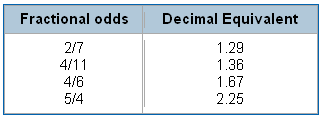When navigating the world of sports betting, one of the fundamental concepts to grasp is betting odds. These odds provide important information about the likelihood of an event occurring and the potential payout a bettor can receive. In this article, we will explore three common types of betting odds: decimal, fractional, and moneyline. Understanding these odds will empower you to make more informed betting decisions.
Decimal Odds
Decimal odds are prevalent in Europe, Canada, Australia, and New Zealand. They represent the potential return on a bet, including the original stake. For example, if a bookmaker offers odds of 2.50 for a particular team to win a soccer match, a $10 bet would yield a total return of $25 ($10 x 2.50). The profit, in this case, is $15 ($25 – $10). Decimal odds are straightforward to understand and widely used in the global sports betting market.
Fractional Odds
Fractional odds, popular in the United Kingdom and Ireland, express odds as fractions. These odds indicate the potential profit relative to the stake. For instance, if the odds on a horse race are 7/1, a $10 bet would result in a profit of $70 ($10 x 7) if the horse wins, in addition to the return of the original stake. Fractional odds can take different forms, such as 2/1, 5/2, or 11/4, conveying different probabilities and potential payouts.
Moneyline Odds
Moneyline odds, commonly used in the United States, represent the amount a bettor must wager to win $100 or the amount won from a $100 wager. Positive moneyline odds indicate the potential profit from a $100 bet, while negative moneyline odds represent the amount needed to wager in order to win $100. For example, if a basketball team has a moneyline of +150, a $100 bet would result in a profit of $150 if the team wins. On the other hand, a moneyline of -200 means a $200 bet is required to win $100 if the bettor’s selection is successful.
Comparing the Odds Formats
It is essential to understand the relationship between the three odds formats to make accurate comparisons. Converting decimal odds to fractional odds involves splitting the decimal number into a fraction. For example, decimal odds of 3.50 become fractional odds of 5/2. To convert fractional odds to decimal odds, divide the numerator by the denominator and add 1. Similarly, converting moneyline odds to decimal odds entails calculating the implied probability and adding 1.
Choosing the Right Format
The choice of odds format is subjective and often dependent on familiarity and personal preference. Decimal odds are more intuitive for beginners as they directly represent the total return on a bet. Fractional odds provide a clear indication of the potential profit relative to the stake. Moneyline odds are favored by American bettors due to their simplicity.
Conclusion
Understanding the various types of betting odds is crucial for any sports bettor. Decimal, fractional, and moneyline odds each offer a unique perspective on the probabilities and potential returns associated with a particular bet. By familiarizing yourself with these odds formats and their conversions, you can make more informed and strategic decisions when placing bets. Whether you prefer decimal, fractional, or moneyline odds, the ultimate goal is to enhance your betting experience and increase your chances of success.

